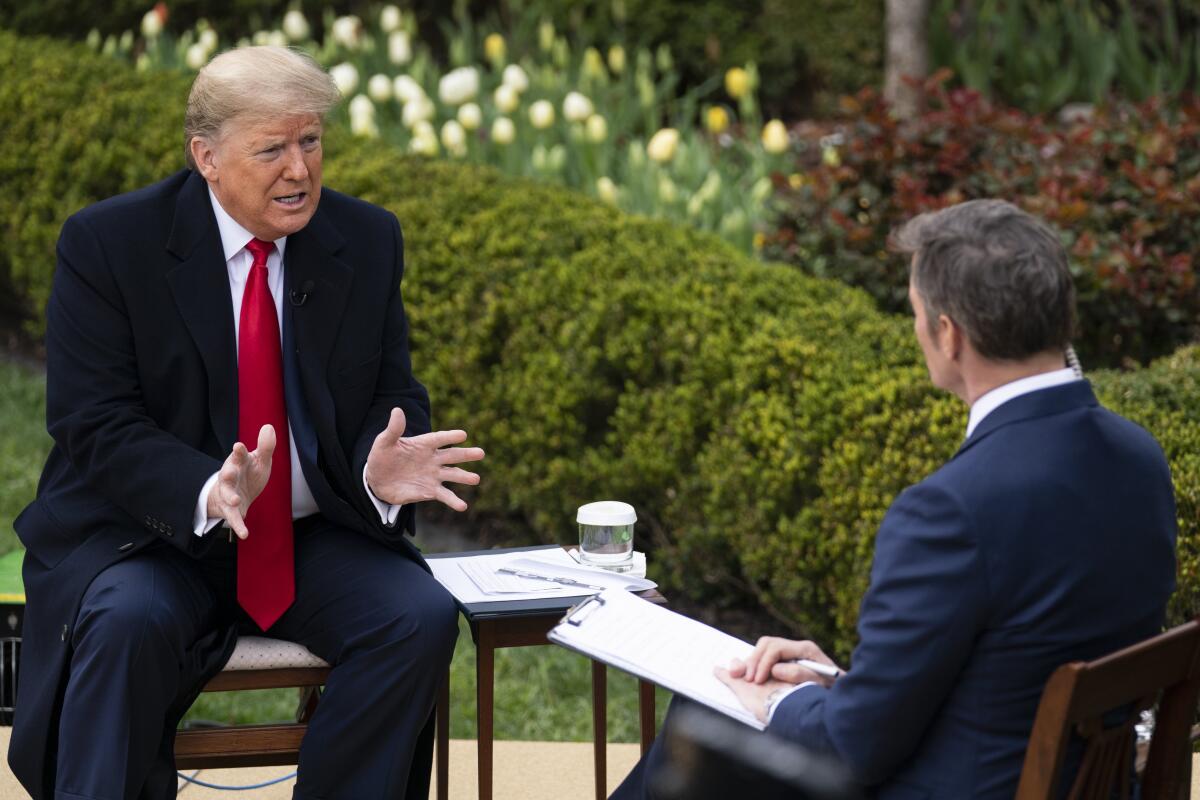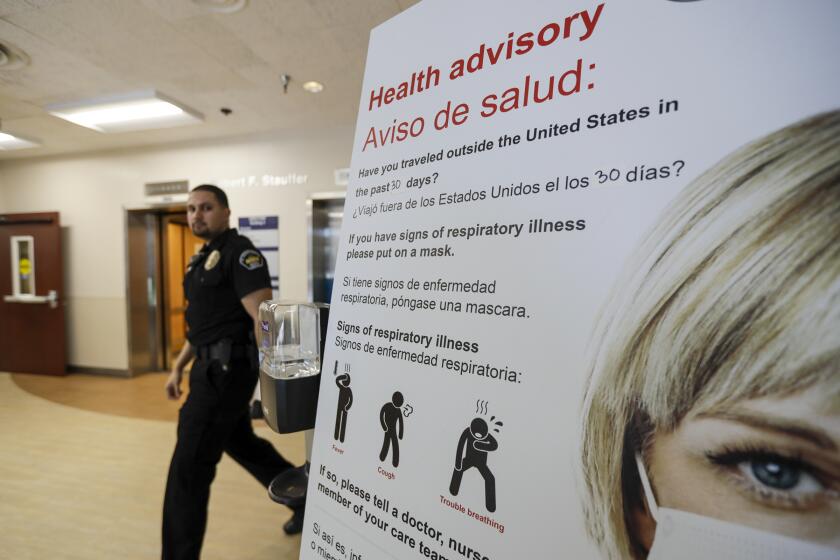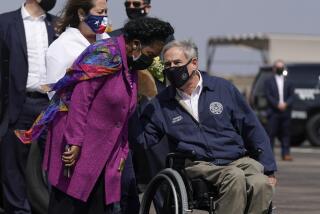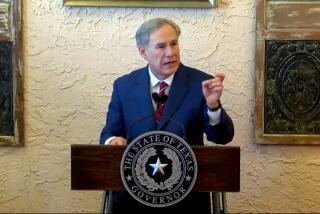Trump and governors in heated debate over saving lives versus the economy

- Share via
WASHINGTON — President Trump and some of the nation’s most prominent governors plunged into heated debate Tuesday over how much death they’re willing to risk in order to get the economy running again during the coronavirus pandemic.
Public health experts warn that they don’t yet know whether the United States is succeeding in slowing the spread of the virus by shutting down schools, shops and restaurants and telling millions of Americans to work from home. Trump, nonetheless, has repeatedly said in the last two days that he wants to quickly ease restrictions.
“I’d love to have the country opened up and just raring to go by Easter,” he said during an appearance on Fox News, where he fielded questions from network hosts and viewers. The holiday would be a “beautiful time” to have “packed churches,” he later said. Doctors have discouraged gathering in crowds during the pandemic.
Trump repeatedly downplayed the threat of the coronavirus by comparing it to seasonal flu, setting aside evidence that the new virus is more deadly and contagious. In the last 24 hours, the U.S. death toll from the illness caused by the coronavirus increased by nearly 100 people, reaching almost 700 total.
“We’ve never closed down the country for the flu,” Trump said. “So you say to yourself, what is this all about?”
His remarks drew sharp rejoinders and resistance from governors in both parties — the officials who have the final say over limitations on daily life.
“If you ask the American people to choose between public health and the economy, then it’s no contest,” New York Gov. Andrew Cuomo, a Democrat, said at a news conference on Tuesday. “No American is going to say ‘accelerate the economy at the cost of human life.’”
“My mother is not expendable. And your mother is not expendable,” he said. “We’re not going to accept a premise that human life is disposable.”
Ohio Gov. Mike DeWine, a Republican, also pushed back against Trump’s suggestion of a rapid return to normal.
“We are going to get our economy back, but we have to get through it, protect as many lives as we can, and then move forward. I’m looking forward to that day, but it’s not yet here,” he tweeted.
DeWine, whose state has confirmed 564 cases of illness from the virus and eight deaths as of Tuesday afternoon, was one of the first governors to order the closure of his state’s schools, restaurants and some other businesses.
Maryland Gov. Larry Hogan, another Republican who has put in place similar restrictions, could not conceal his annoyance when he was asked about Trump’s suggestion of loosening restrictions at the same time he’s trying to keep his state under wraps.
“Some of the messaging coming out of the administration doesn’t match” the messages governors are trying to convey to the public, Hogan said.
He referred to Trump’s timeline as an “imaginary clock” and suggested that his state is weeks away from the peak of coronavirus cases.
California Gov. Gavin Newsom, a Democrat, has tried to avoid directly tangling with Trump over the pandemic but rejected the notion that his state would see businesses open again next month.
“I think April for California would be sooner than any of the experts that I talked to believe is possible,” he said at a news conference Tuesday.
Governments at all levels in the last few weeks have taken steps to slow the spread of the coronavirus through social distancing — urging people to limit public gatherings and limit physical interactions with others.
The goal is to prevent a rapid spike in cases that could overwhelm hospitals with critically ill patients. Health experts consulted by the White House have estimated that if left completely uncontrolled, the COVID-19 disease caused by the virus could kill more than 2 million Americans over the next several months.
Although the vast majority of the restrictions with which the country is living have been ordered by state and local governments, not Washington, Trump a little over a week ago declared a 15-day period, ending March 30, during which he urged people to observe social-distancing restrictions.
He said Tuesday that the guidelines would remain in place “a little bit longer than that,” although he hasn’t set a specific deadline.
Later Tuesday, at a White House briefing, Trump appeared to back away a bit from his Easter timeline, saying “we’ll only do it if it’s good” and that perhaps restrictions could be eased in some parts of the country but not others. He added that he would be guided by recommendations from the medical experts on his coronavirus task force, Drs. Deborah Birx and Anthony Fauci, director of the National Institute of Allergy and Infectious Diseases.
Fauci previously said that he and other health experts could require weeks to determine whether the country was making progress. At the briefing, he said the key issue was figuring out “what’s going on in those areas of the country where there isn’t an obvious outbreak.”
“You can look at a date” for easing restrictions, “but you’ve got to be very flexible,” Fauci said.
Public health experts have cautioned that speeding toward loosening guidelines would be unwise.
“We’ve gone through a lot of trouble by shutting society down,” said David Katz, the founding director of Yale University’s Yale-Griffin Prevention Research Center. “You don’t want to rush to undo that.”
But Trump is eager to find ways to boost the economy, which has stalled since the coronavirus began spreading across the country. The stock market remains wounded despite rebounding on Tuesday, and unemployment claims are spiking as businesses lay off workers now that consumers are marooned at home.
“It’s been very painful for our country, and very destabilizing for our country,” Trump said. “We’re going back to work much sooner than people thought. And people can go back to work and they can also practice good judgment,” he said, adding that people can be safe by washing hands to limit transmitting the virus.
He warned that economic problems could create their own public health problems, saying that financial distress could lead “thousands” to commit suicide, and he likened the threat of the coronavirus to car crashes.
“We didn’t call up the automobile companies and say, ‘Stop making cars; we don’t want any cars anymore,’” Trump said. “We have to get back to work.”
Those comparisons lack comparable scale. The Great Recession that followed the financial crisis of 2008 led to an estimated 12,940 suicides across North America and Europe, according to a study published in the British Journal of Psychiatry, and car accidents caused about 36,000 deaths in 2018, the latest year that federal statistics are available.
But Trump has been hearing from many conservative commentators and politicians who say the restrictions are excessive.
“There certainly are risks with reopening the economy,” said Steve Moore, a former economic advisor to Trump’s 2016 campaign who remains in touch with the White House. “That’s indisputable. The real question is, what are the risks of not reopening the economy?”
Some went a step further than Moore, suggesting that grandparents would be willing to take more risks in order to help the country.
Why does the coronavirus prompt dire warnings from the CDC about quarantines, school closures and other disruptions when we face flu season each year?
“No one reached out to me and said, ‘as a senior citizen, are you willing to take a chance on your survival in exchange for keeping the America that all America loves for your children and grandchildren?’” Texas Lt. Gov. Dan Patrick, a Republican, told Fox News on Monday. “And if that’s the exchange, I’m all in.”
Cuomo and other opponents of those arguments say they amount to sacrificing the most vulnerable for the sake of those who are already better off.
“We’re not going to put a dollar figure on human life,” Cuomo said.
Katz, now the president of the True Health Initiative, a nonprofit organization, is sensitive to the concerns that economic problems could create new problems.
“There is more than one way for lives to be lost or ruined,” he said.
For now, the country lacks enough data to make clear recommendations about whether people can head back to work. Most important, he said, researchers need to know more about how the disease affects young people in the United States.
“Are we at greater risk across the age spectrum?” he said. “Sadly, it’s a possibility. We need to know if it’s a reality.”
If young people are indeed less vulnerable, as indicated by experiences with the coronavirus in other countries, there could be a way to ease back into normal life by focusing healthcare resources on the elderly, Katz said. As more data can be analyzed, policymakers can make smarter choices, he said.
“We can answer that question in as little as two or three weeks,” he said.
Times staff writer Phil Willon contributed to this report from Sacramento.
More to Read
Get the L.A. Times Politics newsletter
Deeply reported insights into legislation, politics and policy from Sacramento, Washington and beyond. In your inbox three times per week.
You may occasionally receive promotional content from the Los Angeles Times.












